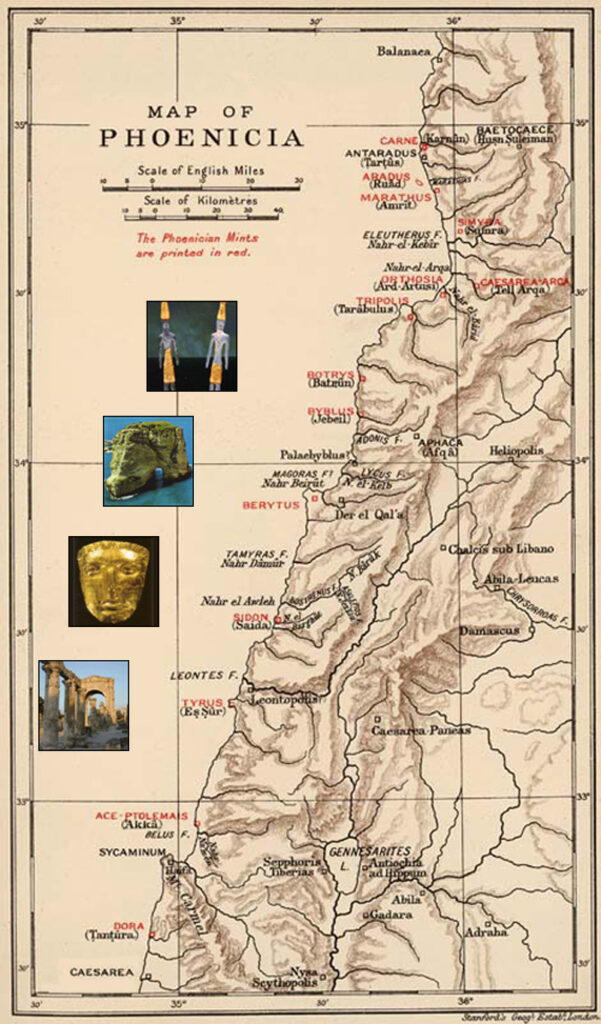
The people of Phoenicia — which we know today as Lebanon — lived for more than a thousand years as free and independent Phoenicians, the ancient people whose name was given to this land. After the conquest by Alexander the Great in 332 BC, their homeland took on new life as Greek-dominated Phoenicia. When the Romans took their turn as conquerors of this much-desired country, it then began to live as Roman-dominated Phoenicia. Each of these eras had its own unique character.
Phoenicians in Phoenicia
From their earliest days in Byblos, the Phoenicians developed a unique and memorable society around their sea trade and valuable cedar wood. They founded cities at Sidon and Tyre, then spread up and down the coast of what would come to be known as Lebanon creating cities at Beirut, Arwad, and other locations. Inland they went high into the Lebanon Mountains and down the eastern side into the Bekaa Valley, where Zahlé and other cities grew.
Phoenicia also extended across the sea to many colonies such as Carthage in North Africa, Ikosim (Algiers) in Algeria, Tingis (Tangier) in Morocco, Gadir (Cadiz) in Spain, as well as colonies in Sardinia, Corsica, Malta, Sicily, Crete, Santorini, Rhodes, Cyprus and many other locations.
During this time the Phoenicians were largely independent and self-reliant. But they also were attentive to their relationships with larger and more populous lands such as those of Egypt, Persia, Greece and Rome. In their later years they frequently had “overlords” on the mainland part of Phoenicia. However the freedom of the seas and their many colonies allowed them considerable independence and negotiating room, even on the mainland. When the neighboring Hebrews were taken away to Babylon in captivity, the Phoenicians simply paid tribute in gold to Babylon — then continued to live in their own cities and went about their business.
This independence was reduced in 332 BC when Alexander the Great arrived with his army and placed mainland Phoenicia under Greek control. It plummeted further when Rome destroyed Carthage in 146 BC, ending the overseas “safety valve” of the Phoenicians.
Greeks in Phoenicia
The life of Phoenicia became less glamorous under Greek rule, particularly after 146 BC, as the people of Phoenicia adjusted to Greek government and language. This was not entirely “Greek” as we normally think of it, with decisions coming from Greece, because upon the death of Alexander the Great his empire was split into three parts: Greece, Egypt and Asia. Phoenicia fell into the Asian empire, ruled by a king in near-by Antioch. Nevertheless, the language of administration, if not in the streets, was Greek, and life went on.
The Greeks had their own problems, so the people of Phoenicia retained a moderate degree of freedom to conduct their affairs. The king at Antioch was preoccupied with rebellions and wars in the region now known as Afghanistan and Pakistan, as well as other concerns. Life in Phoenicia was such that when Hannibal lost the Second Punic War to Rome, he fled Carthage and took up residence in lands belonging to the king of Antioch. That was not much protection, however, for the Romans pursued Hannibal to the city of Libyssa, where he took poison to avoid capture.
The Romans were also fighting on-going wars with the kings of Greece, eventually subduing those lands and working their way around to Phoenicia. The Roman general Pompey marched into Phoenicia in victory during 63 BC, and planted the banner of his legion there.
Romans in Phoenicia
During this period, the attention of the Romans was mostly directed elsewhere. The neighboring Hebrews fought numerous revolts against the Rome, as well as raising a carpenter’s son named Jesus of Nazareth who caused an upheaval of a different nature. One of the few areas in which the people of Phoenicia caught the attention of Rome was in their strong foundation of law. There were three great schools of law during the Roman period — at Rome, Constantinople and Beirut. The other significant area of interest was in houses of worship, due to the massive temples built at Baalbek, which were believed to have been placed upon an earlier Phoenician temple.
When the huge and ponderous Roman empire eventually became split between East and West, Phoenicia fell into the Eastern half. The emperor for this half resided at Constantinople, which is today known as Istanbul. When the Western half of the Roman empire was destroyed by the fall of Rome and other depredations in Europe by Goths, Vandals and others, the Eastern empire just went on as before. Over time, the Eastern Roman empire has become known as the Byzantine Empire. Phoenicia likewise continued as before, simply acknowledging the Byzantine overlord. Christianity came to Phoenicia during this time, and in short order virtually the whole country was Christian.
Those hundreds of years of Roman and Byzantine rule came to an end in the Arab Conquest which took place in 636 AD. The uneasy relationship that came into existence at that time between Muslims and Christians has continued in greater or lesser degree to the present day.
Legacy of Phoenicia
Although outsiders called their land Phoenicia, the Phoenicians called it their land of the white (snow-covered) mountains. Their word for white was lbn. Intriguingly, their country is still known today by its original Phoenician name.
The boundaries of Lebanon are remarkably similar to the old boundaries of Phoenicia, and the land is still home to many descendants of the original Phoenicians. They live today with much of their original Phoenician culture still visible, albeit with Greek, Roman, Arab and other contributions.
The content of this website is drawn from the research of historian Sanford Holst

Updated February 4, 2024
CLOUD: Phoenicia, Phoenician history

Further information
If you would like to experience more of the Phoenician world than you find in these short articles, see the book Phoenicians: Lebanon’s Epic Heritage. This extensive exploration is brightened with 104 illustrations.
Going beyond the few traditionally-cited facts, this authoritative work draws from discussions with leading archaeologists and historians to discover new clues and lines of inquiry into this secretive society.
Phoenicians
You can take a look inside this book. See the first pages here.
